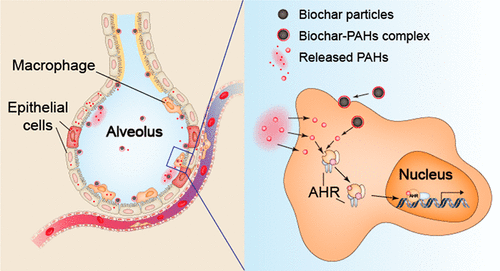当前位置:
X-MOL 学术
›
Environ. Sci. Technol. Lett.
›
论文详情
Our official English website, www.x-mol.net, welcomes your feedback! (Note: you will need to create a separate account there.)
Biochar Fine Particles Enhance Uptake of Benzo(a)pyrene to Macrophages and Epithelial Cells via Different Mechanisms
Environmental Science & Technology Letters ( IF 10.9 ) Pub Date : 2020-12-29 , DOI: 10.1021/acs.estlett.0c00900 Xinlei Liu 1 , Juan Ma 2, 3 , Rong Ji 4 , Songfeng Wang 4 , Qiurong Zhang 1 , Chengdong Zhang 1 , Sijin Liu 2, 3 , Wei Chen 1
Environmental Science & Technology Letters ( IF 10.9 ) Pub Date : 2020-12-29 , DOI: 10.1021/acs.estlett.0c00900 Xinlei Liu 1 , Juan Ma 2, 3 , Rong Ji 4 , Songfeng Wang 4 , Qiurong Zhang 1 , Chengdong Zhang 1 , Sijin Liu 2, 3 , Wei Chen 1
Affiliation

|
Biochars are widely used as soil amendments and are major sources of agricultural dusts. Inhalation of biochar fine particles can increase the exposure of respiratory systems to mutagenic and carcinogenic polycyclic aromatic hydrocarbons (PAHs) that are bound to the materials during pyrolysis of biomass, but the specific mechanisms are elusive. Here, we show that biochar fine particles enhance the intracellular transfer of benzo(a)pyrene (a model PAH) into the J774A.1 macrophage via the “Trojan-horse” mechanism; i.e., the endocytosed benzo(a)pyrene-bearing particles act as a vector to deliver benzo(a)pyrene into the cells. Notably, biochar particles are found to serve as a reservoir that continuously releases benzo(a)pyrene into the lung fluids. Thus, benzo(a)pyrene bound to biochar is available to the neighboring cells such as lung epithelial cells (tested with A549 cells), even without apparent endocytosis. The aryl hydrocarbon receptor activation tests and in vitro bioaccessibility assays further corroborate these findings, in that benzo(a)pyrene carried into the lungs by biochar fine particles is still toxic to lung cells, and the cytotoxicity can be predicted based on the bioaccessibility in lung liquids. This work unearths the cell-specific risk pathways via which biochar fine particles break respiratory defense systems by serving as both contaminant vector and reservoir.
中文翻译:

生物炭细颗粒通过不同机制增强对巨噬细胞和上皮细胞的苯并(的吸收
生物炭被广泛用作土壤改良剂,是农业粉尘的主要来源。吸入生物炭细颗粒会增加呼吸系统对生物质热解过程中与材料结合的致突变和致癌多环芳烃(PAH)的暴露,但具体机制尚不清楚。在这里,我们显示生物炭细颗粒通过“特洛伊木马”机制增强了苯并(a)re(PAH模型)进入J774A.1巨噬细胞的细胞内转移。也就是说,内吞的含苯并(a)re的颗粒充当将苯并(a)re传递到细胞中的载体。值得注意的是,已发现生物炭颗粒充当将苯并(a)continuously连续释放到肺液中的储库。因此,即使没有明显的内吞作用,结合到生物炭上的苯并(a)is也可用于邻近的细胞,例如肺上皮细胞(经A549细胞测试)。芳烃受体活化试验和体外生物可及性测定进一步证实了这些发现,因为生物炭细颗粒带入肺中的苯并(a)re仍然对肺细胞有毒性,并且可以根据肺液中的生物可及性预测细胞毒性。这项工作发掘了细胞特有的风险途径,生物炭细颗粒既可作为污染物载体也可作为蓄水池,从而破坏呼吸防御系统。
更新日期:2021-03-09
中文翻译:

生物炭细颗粒通过不同机制增强对巨噬细胞和上皮细胞的苯并(的吸收
生物炭被广泛用作土壤改良剂,是农业粉尘的主要来源。吸入生物炭细颗粒会增加呼吸系统对生物质热解过程中与材料结合的致突变和致癌多环芳烃(PAH)的暴露,但具体机制尚不清楚。在这里,我们显示生物炭细颗粒通过“特洛伊木马”机制增强了苯并(a)re(PAH模型)进入J774A.1巨噬细胞的细胞内转移。也就是说,内吞的含苯并(a)re的颗粒充当将苯并(a)re传递到细胞中的载体。值得注意的是,已发现生物炭颗粒充当将苯并(a)continuously连续释放到肺液中的储库。因此,即使没有明显的内吞作用,结合到生物炭上的苯并(a)is也可用于邻近的细胞,例如肺上皮细胞(经A549细胞测试)。芳烃受体活化试验和体外生物可及性测定进一步证实了这些发现,因为生物炭细颗粒带入肺中的苯并(a)re仍然对肺细胞有毒性,并且可以根据肺液中的生物可及性预测细胞毒性。这项工作发掘了细胞特有的风险途径,生物炭细颗粒既可作为污染物载体也可作为蓄水池,从而破坏呼吸防御系统。



























 京公网安备 11010802027423号
京公网安备 11010802027423号